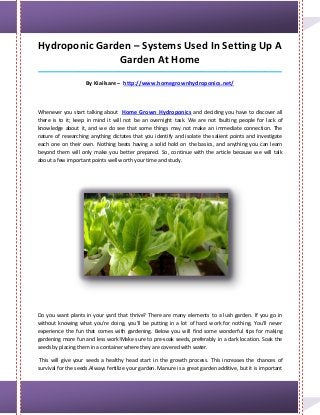
Home grown hydroponics
- 1. Hydroponic Garden – Systems Used In Setting Up A Garden At Home _____________________________________________________________________________________ By Kiailsare – http://www.homegrownhydroponics.net/ Whenever you start talking about Home Grown Hydroponics and deciding you have to discover all there is to it; keep in mind it will not be an overnight task. We are not faulting people for lack of knowledge about it, and we do see that some things may not make an immediate connection. The nature of researching anything dictates that you identify and isolate the salient points and investigate each one on their own. Nothing beats having a solid hold on the basics, and anything you can learn beyond them will only make you better prepared. So, continue with the article because we will talk about a few important points well worth your time and study. Do you want plants in your yard that thrive? There are many elements to a lush garden. If you go in without knowing what you're doing, you'll be putting in a lot of hard work for nothing. You'll never experience the fun that comes with gardening. Below you will find some wonderful tips for making gardening more fun and less work!Make sure to pre-soak seeds, preferably in a dark location. Soak the seeds by placing them in a container where they are covered with water. This will give your seeds a healthy head start in the growth process. This increases the chances of survival for the seeds.Always fertilize your garden. Manure is a great garden additive, but it is important
- 2. that you choose a manure that has been composted commercially so that there is less of a risk of pathogens. You must be sure to use some kind of fertilizer. There are many different combinations available for different uses.Gradually acclimate plants to temperature changes and conditions, if you want to avoid shocking them. Leave them outside in sunlight for a couple of hours on the initial day. Over a period of several days, slowly increase the time they are allowed to stay outside. By the weekend, the plants can make that big move without a problem!Plant things that will give you color for the fall. That need not be the case though! When it comes to brightly colored foliage, fall is an amazing time of year. For example, maple, beech, and dogwood trees all change from their usual green to a vibrant spectrum of yellow, orange, and red. Add even more color to your garden by planting shrubs such as hydrangea, barberry or cotoneaster.Learn about plant varieties so you can choose the ones with the best yields. If yield is important, choose hybrids designed to resist cold and diseases rather than traditional varieties.Irrigate your garden efficiently. You can water efficiently by using a soaker hose which will eliminate the necessity of watering each plant one by one with a nozzle, or having to use a water can that you have to refill over and over. To protect your plants, keep the flow on the soaker down. It can water the plants for two hours so that you can do other things. Different types of bees can be an asset to your garden. For effective pollination, bumble bees are a great help. Unfortunately there are other types of bees are harmful. Carpenter bees, for instance, eat holes in wood to create nests. But mostly, bees are helpful in the gardening process, so in most cases you should let them do what they need to do.Use annuals and biennials to brighten your flower garden. These
- 3. flowers grow quickly and can be planted at any time during the year. If you want to maintain a flower garden all year or you want to add new flowers to reflect the changing seasons, annuals and biennials are for you. You can also use these flowers to fill gaps between shrubs or perennials. You should get varieties such as cosmos, petunia, rudbeckia, hollyhock, sunflowers or marigold.Use climbers to cover walls and fences. These types of plants can climb anything, which makes them perfect for covering up a wall or fence that needs to be hidden. Climbers can also be trained to grow and cover an arbor, and they will grow through or around existing trees and shrubs. Some must be tied onto a support, but a number of climbers attach to surfaces with twining stems or tendrils. Climbing roses, honeysuckle, wisteria, clematis, and jasmine are some great plants to try out. So... What's Next ? To learn more about Home Grown Hydroponics, Click Here : http://www.homegrownhydroponics.net/